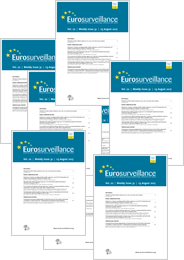- Home
- Weekly releases (1997–2007)
- Previous Issues
- Volume 6, Issue 48, 28/Nov/2002
Weekly releases (1997–2007) - Volume 6, Issue 48, 28 November 2002
Volume 6, Issue 48, 2002
- Articles
-
-
-
Diagnosis of lyssavirus infection confirmed in case of human rabies in Scotland - update
More LessLaboratory results of tests on the case of suspected rabies in Tayside, Scotland, have shown that the man was infected with European bat lyssavirus (EBL) type 2. (1,2). The patient died on 24 November 2002 (3).
-
-
-
Eastern Europe and Central Asia still home to world's fastest-growing HIV/AIDS epidemic
More LessThe unfortunate distinction of having the world's fastest-growing HIV/AIDS epidemic still belongs to eastern Europe and Central Asia, according to the report, AIDS epidemic update 2002, released this week (1). In southern Africa, the HIV/AIDS epidemic has greatly decreased the capacity of farm communities to survive famine (2). The update on the global HIV/AIDS epidemic was issued by the Joint United Nations Programme on HIV/AIDS (UNAIDS) and the World Health Organization, in advance of World AIDS day on 1 December.
-
-
-
Paris syphilis screening campaign extended to selected French towns and cities
L Pritchard and E HoileMore LessSyphilis cases in France have been increasing rapidly since 2000. Cases of infectious syphilis diagnosed in Paris increased from 30 in 2000 to 148 in 2001, and 203 were reported between January and October 2002 (1). In light of the resurgence of syphilis in France and other European countries in recent years (2-6), the French authorities began a syphilis screening campaign in Paris in May 2002. Syphilis has not been a notifiable disease in France since 1986, but in 2000, the Institut de Veille Sanitaire (InVS) set up a surveillance network that included clinical settings, including STI clinics (Dispensaires antiveneriens, DAV), dermato-venereology clinics, and internal medicine clinics.
-
-
-
Outbreak of multidrug resistant Salmonella Typhimurium DT120 in Denmark
More LessFrom August to October 2002, a total of 41 human cases of multidrug resistant Salmonella enterica subsp. enterica serotype Typhimurium resistant to ampicillin, tetracycline, streptomycin and sulfamethoxazole (R-type ASSuT) were reported in Denmark. Cases were not confined to one region, but were spread out over most of the country. At least 10 of the patients were hospitalised. No deaths have been recorded. Until August 2002, S. Typhimurium R-type ASSuT was uncommon in human isolates. From 1997 to July 2002 a total of 81 (2.5%) strains with this resistance profile were found in 3114 cases of S. Typhimurium tested for antimicrobial susceptibility.
-
-
-
Danish study finds no causal relationship between MMR vaccine and autism
More LessDanish researchers from the Danish Epidemiology Science Centre at the University of Aarhus and the Statens Serum Institute in Copenhagen found no increased risk of autism among children who had been given measles, mumps, and rubella vaccine (MMR) compared to children who were not vaccinated (1). The study, which was very large, and the first to use a population based cohort design, adds further evidence for the absence of any causal relationship between MMR vaccine and autism. It is thus in agreement with other studies designed to evaluate the suggested link (2-4).
-
-
-
SWEDRES 2001 - report on Swedish antibiotic use and resistance in human medicine
More LessAntimicrobial resistance is an increasing threat to human health. Although the prevalence of resistant bacteria in Sweden is low in comparison to many other countries, international trends are alarming and resistance genes do not respect any borders. Recently, the first yearly report on surveillance and control systems for both antibiotic use and resistance was published and made available on the Internet (1). The report is a joint collaboration between the Swedish Institute for Infectious Disease Control (SMI, <a href="http://www.smittskyddsinstitutet.se"> http://www.smittskyddsinstitutet.se</a>) and the Swedish Strategic Programme for the Rational Use of Antimicrobial Agents (STRAMA, <a href="http://www.strama.org"> http://www.strama.org</a>). This first yearly report covers data from 2001 and from previous years. Most resistance data have been routinely collected from the local laboratories by the SMI and the Swedish Reference Group for Antibiotics and its subcommittee on methodology (SRGA-M, <a href="http://www.srga.org/"> http://www.srga.org/</a>), but data on specific organisms for the SWEDRES Report were also sent from individual contributing laboratories.
-
-
Most Read This Month

-
-
Chikungunya in north-eastern Italy: a summing up of the outbreak
R Angelini , A C Finarelli , P Angelini , C Po , K Petropulacos , G Silvi , P Macini , C Fortuna , G Venturi , F Magurano , C Fiorentini , A Marchi , E Benedetti , P Bucci , S Boros , R Romi , G Majori , M G Ciufolini , L Nicoletti , G Rezza and A Cassone
-
- More Less


